Our Rastakhan’s Rumble Holy Wrath Paladin deck list guide will help you learn how to better pilot this deck. Our guide features mulligan, play, and card replacement strategies!
Introduction to Holy Wrath Paladin
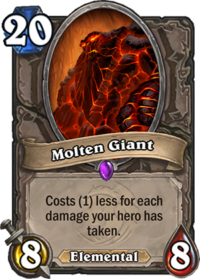
Holy Wrath was always an interesting build-around card. It’s obviously a very random spell, but drawing a high cost cards makes it extremely good. The problem was that even 10 mana cards weren’t strong enough to compensate for the randomness, but there was one card that worked just fine with it – Molten Giant. First at 20 mana cost and later, after a nerf, at 25, it packed enough punch to consider building the entire deck around it. Of course, without a consistent way to guarantee that Molten Giant will be the card you pull out, it was only a meme deck, working maybe in one out of 10-15 games.
The combo got a bit more consistent in Journey to Un’Goro, when you could play Hemet, Jungle Hunter to sift through all of the low cost cards and then punch them with 25 damage Molten Giant that’s still left in the deck. It was still an inconsistent combo, and the deck’s core had to be full of 1-3 mana cards, making it a very questionable choice. And then, when Molten Giant was un-nerfed and moved to Hall of Fame, making it available only in the Wild format, the dreams of having a viable Holy Wrath combo in Standard were crushed. Until recently.
In Rastakhan’s Rumble, not only the deck did come back, but it came back in a big way. Not many players have expected that Holy Wrath Paladin will turn out to be a viable deck, let alone a great one that multiple players have put in their tournament lineups. The current combo revolves around Shirvallah, the Tiger, which despite being one of, works much better in this kind of strategy than a nearly unplayable Molten Giant.
Holy Wrath Paladin Deck List
Find more versions of this deck type on our Holy Wrath Paladin archetype page!
Secret Hunter Mulligan Guide
VS Fast Decks
Higher Priority (Keep every time)
- Righteous Protector – The only Turn 1 play in this deck, you want to keep it, because it provides some early game defense and might be able to trade into another small minion.
- Crystology – The best card draw in this build – draws 2 cards for 2 mana, has a solid chance to give you more draw or ways to stall the game. Even against Aggro, it’s something you want to have, as drawing more cards brings you closer to your defensive moves.
Lower Priority (Keep only if certain conditions are met)
- Equality + Wild Pyromancer – Keep those two as a package. The thing about Aggro matchups is that if you don’t get those cards by the mid game, you usually lose the game, because you have very limited ways of clearing the board. But after your opponent commits to the board, clearing everything for just 4 mana is amazing.
- Consecration – Keep vs board flood decks, such as Odd Paladin.
- Hammer of Wrath – With some other early game plays. It’s good, because it removes something and cycles, lowering the pressure on the board a bit and getting you closer to the cards you need at the same time.
VS Slow Decks
Higher Priority (Keep every time)
- Crystology, Prismatic Lens, Novice Engineer, Bloodmage Thalnos – Against slower decks, which shouldn’t put that much pressure in the early game, card draw is basically the only thing you want. Ordered from the best to worst to keep.
Lower Priority (Keep only if certain conditions are met)
- Equality – Keep in certain matchups, in which your opponent might drop a big minion early, e.g. against Even or Cube Warlock.
Holy Wrath Paladin Play Strategy
The basic idea behind the deck is to draw your entire deck, play Shirvallah, the Tiger for 0 mana, shuffle it back into your deck with Baleful Banker and immediately play Holy Wrath to shoot your opponent for 25 damage. Despite the Shirvallah’s cost being 0 in your hand, Holy Wrath looks at the card’s BASE mana cost, which is 25 in case of the Tiger Loa.
Vs Fast Decks
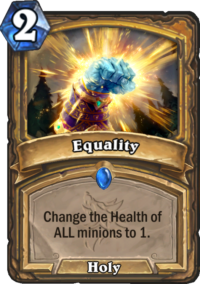
Against faster decks, you can pretty much forget about your combo. You play the game as a Control deck and usually win by running them out of resources while still being alive. If the game goes long enough, they get a great long distance hand and still have stuff to do when you’re nearly out of cards, then you can combo them.
Against Aggro, like always, the most important thing to do is surviving. The deck is so much focused on cycle that it doesn’t run many board clears, but that’s not a problem. Two Equality combos (with either Wild Pyromancer or Consecration) should be enough if you don’t use them on boards you don’t have to. Instead of board clears, it runs some ways to stall the game and buy you some more time. Righteous Protector, for example, is a great one. Let’s say that your opponent has two 3 attack minions on the board. Dropping Protector forces them both to hit it, meaning that you save yourself 6 health for just 1 mana. It doesn’t do much in terms of clearing the board, but it buys you more time and encourages opponent to play more minions into your clears.
You can also heal up with Flash of Light – healing for 4 and drawing card is great. If you have him in your hand already, and you have enough free mana, you can also drop Crystalsmith Kangor to double the healing – it’s pretty annoying for your opponent, because now he also has to clear Kangor, which is usually another 4 points of health for you. If you’re not in a hurry you might want to save Kangor for Shirvallah, but the 7 burst healing and removal is usually good enough by itself and Kangor is useful earlier – keeping him too long is a common mistake.
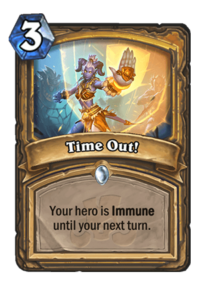
But the absolute best stall card is Time Out!. It buys you an entire turn, no matter how big of a board you face. It’s even better if you can drop some card draw etc. at the same time to also progress with your main game plan. Don’t use it on a small boards, you can afford to take let’s say 4-5 damage most of the time, but don’t be too greedy with it – if you face 10 damage and have no way of reducing that or healing yourself up, using Time Out might be a good idea (especially if you have two). After you drop Time Out, your opponent will usually just develop some more stuff and pass, giving you a great opportunity to drop an Equality combo next turn. If it’s later into the game and you already have Uther’s weapon equipped, you can also use Time Out before attacking into a big minion to “heal” you up immediately by making you immune. It might be a good idea if you want to attack into a 7/7, 8/8 or some other big minion like that.
After you’ve cleared the board with Equality, your opponent will most likely try to develop again. If you have a second Equality, you can just let them and do the same thing again. If you don’t, try to clear as much as you can with Hammer of Wrath and Holy Wrath. Yes, Holy Wrath too – playing one is absolutely fine, you never need two against Aggro. Sometimes you don’t even need a single one, so if you’re in a desperate situation and you need removal, using the second one can also be fine. It’s important to play your spells in order to make Shirvallah, the Tiger cheaper. Because most of the time, Shirvallah is your main win condition vs Aggro.
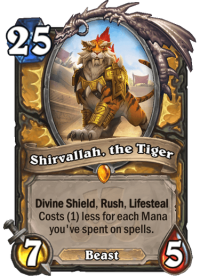
Once you get Shirvallah down to 0 mana, you can drop her, clear something immediately, heal up, and still have a 7/5 on the board. Ideally, you want to follow her up with Zola the Gorgon to get her back to the hand. You can also play your Baleful Banker now, especially if you don’t have Zola. 0 mana 7/5 with Rush, Divine Shield and Lifesteal is so much tempo that Aggro decks often fall at this point, they have no way to catch up. If you were low and they were trying to burn you down, dropping Crystalsmith Kangor at the same time can also be a great, increasing the healing to 14.
One interesting way to win in slow matchups is to draw Shirvallah, the Tiger from Prismatic Lens. While it will make the spell you draw absolutely unplayable, Shirvallah will basically always cost 0 mana. If you get 0 mana Shirvallah on Turn 4, it can actually lead to some very early wins – it might be very hard for an Aggro deck to overcome it. Just keep in mind that only this one copy will cost 0 – if you get it back with Zola or shuffle with Bankers, new copies will have their regular mana cost.
If you get that late into the game, Uther of the Ebon Blade usually seals it completely, unless your opponent has a massive board. The weapon is just amazing – not only it can remove 3 mid-sized minions, but also heals you up by a lot at the same time. Between Uther, Shirvallah etc. you should run your opponent out of cards and win the game just like that.
But if for some reason you didn’t win yet, if your opponent had some great ways to refill etc. then you can still play your combo. That’s why you ideally want to save one copy of Shirvallah, one Banker and one Holy Wrath. If you get that far into the game and they still aren’t dead, then you just drop Shirvallah, shuffle her and Holy Wrath your opponent’s face for 25 – that should be enough to win the game. And if for some reason you had to use all of your pieces before and still haven’t won the game, you can try to go for the 4 Horsemen from Uther. Aggro decks generally lack direct removals other than weapons, and you might be able to hide the Horsemen behind Righteous Protector. It’s not that easy, as it takes three turns of them not having a way to answer them, but it can work if you have Shirvallah on the board, maybe a weapon in your hand, or other means to protect them.
Vs Slow Decks
Holy Wrath Paladin is actually one of those decks where games against Control decks might be more straightforward than those against Aggro. Here, you have basically one and only one win condition – your Holy Wrath combo. Unlike Aggro, which can run out of resources quite easily, Control decks won’t crumble after you clear their board twice and then drop two Shirvallahs. Most of the time they will be able to deal with it, so you absolutely have to combo.
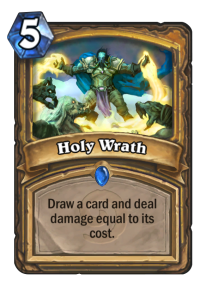
First, very important thing is realizing whether you need two combos or a single one is enough in a given matchup. Combo deals 25 damage, which is not exactly enough to OTK the opponent. Against lots of decks, you should be able to deal the other 5 damage with weapon, through chip damage from minions, or they might even deal it yourself for you (e.g. Warlocks). However, if you face a deck which can easily regain health or get a lot of Armor – e.g. Odd Warrior, different kinds of Druid – one combo won’t be enough. Against Warrior in particular, there is another way to win the game (I will detail it later), but let’s say that you face a Control Priest. Especially if they run weapon removal for your Uther of the Ebon Blade, if they play it smart, you might not be able to kill them. So saving double combo can be crucial sometimes. It’s important to know whether you need double or only a single combo, because if only one is enough, then you can use your first Holy Wrath to cycle faster and make your Shirvallah 0 mana quicker.
Against slower decks, cycling is most important. Most of the time, you don’t really fight against your opponent, but against time. It’s especially apparent against decks like Odd Warrior, when they get 4 more Armor each turn, meaning that you have to perform your game plan as quickly as possible. But against other slow decks, it’s the same – they won’t likely put much pressure on you in the early game, and then you only have two big board swipes for the mid/late game. So once those are gone, any big minion played by your opponent is a potential deadly threat. You still have two Time Outs to buy you more time, but after that you’re most likely dead if you don’t kill them. Luckily for you, this deck cycles like crazy. Roughly half of your deck is some kind of card draw or cycle, so you can get through your entire deck and prepare the combo by Turn 10 quite often. You don’t have to think about efficiency, Hero Powering, making as much use of your cards as possible. No, you just want to play everything. You have Hammer of Wrath in your hand but no good targets for it? Just hit their Hero. You have Potion of Heroism and only a minion with Divine Shield on the board? You can still play it, Divine Shield part is not that important vs slow decks, you just want to cycle it.
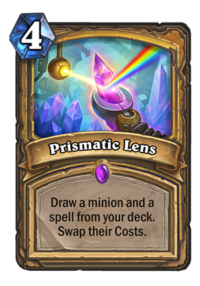
Technically, Prismatic Lens can mess up with your plans a bit, especially if you’re going for double combo. If you draw exactly Shirvallah and Holy Wrath, the Holy Wrath will be unplayable, leaving you with only one of them. Does it mean that you don’t play your Prismatic Lens when you face a matchup against which you want the double combo? Absolutely not! You HAVE to play it no matter what. Not only the chance to get those two specific cards is quite low, but leaving it in your hand instead of playing it slows you down considerably, giving your opponent more time to get the cards they need, which is a much more realistic threat than low-rolling a Prismatic Lens. It will happen from time to time, but don’t worry about that. If you have other ways of drawing cards, you can still use those first, hopefully drawing Shirvallah or both of your Holy Wraths. But if Prismatic Lens is the only draw you have left in your hand, you absolutely want to go for it.
If all else fails, if you’re in a desperate situation, you’re dying, you have almost no way to win the game, you can still go for one more play. If Shirvallah is still in your deck, and you have Holy Wrath in your hand, just go for it. Similarly, if you have a free or cheap Shirvallah and Banker in your hand, you can go for it even if you have some cards still left. If Shirvallah will be one of the 10 cards in your deck, you have a 10% chance to hit your opponent for 25 – sometimes that’s enough, you get lucky and you win the game that you should not win otherwise. It happens every once in a while, and it feels great (for you, not for your opponent).
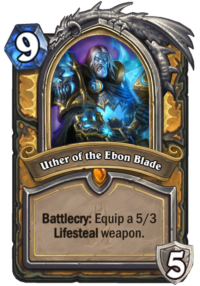
After you get to the bottom of your deck, what you want to do is play Shirvallah, Banker, and then Holy Wrath opponent for 25. If you saved a double combo, you can do the same thing again next turn – it’s impossible to get both on the same turn, but that’s rarely a problem, especially with Time Out!. 25 damage is already enough in lots of the matchups, but 50 is basically enough to kill anyone, right? Well, not exactly. For example, Odd Warrior can EASILY gain much more than that. You would need A LOT of chip damage throughout the game for 50 to be enough to kill them if they play it smart. That’s why in this specific matchup, or any other matchup that you can’t win through damage (e.g. sometimes against Druids), you have an alternative way to win the game – thanks to Uther of the Ebon Blade.
In this scenario, you ignore your Holy Wrath win condition. You can use both of your Holy Wraths to cycle, and drop Shirvallah any time you need. Instead, you want to use your Zola the Gorgon and two Baleful Bankers on your Horsemen. You basically play the regular OTK Paladin’s game here – when you roll an unique Horseman, you shuffle it in your deck or copy with Zola. But you have to be careful and remember which ones you’ve already shuffled into your deck – shuffling the same Horseman twice is a great way to lose the game. Bankers are less effective than immediate bounces or Zola, because you still need to draw them, but against a deck like Odd Warrior, which doesn’t have many ways to put pressure, it should still be enough. After you Banker/Zola three unique Horsemen, you want to start cycling through your deck again to draw them. Then drop all three, press your Hero Power one last time and win the game. That’s one of the reasons why this deck is so good – it can do the same thing as Exodia Paladin (a little less efficiently, but still) and it also has the Holy Wrath win condition.
Holy Wrath Paladin Card Substitutions
Holy Wrath Paladin is a rather expensive deck. There are variety of builds, but most of them cost between 8k and 12k Arcane Dust. The deck runs some Epics and quite a lot of Legendary cards, but sadly, most of them are necessary to play the deck and you can’t replace them. I will still go through the list and see which ones can be switched out.
- Bloodmage Thalnos – Thalnos is mostly used as a card draw. Sometimes getting down a 3 damage Consecration comes handy. Normally it could be replaced with Loot Hoarder without any problems. However, in this case, Loot Hoarder is much worse, since it can’t be drawn with Crystology. That’s why I’d probably go for Acolyte of Pain instead, but Loot Hoarder can also be fine if you want to risk not running enough minions for Crystology.
- Crystalsmith Kangor – Kangor is a really solid card – even as a standalone 2-drop it usually heals you for a bunch and possibly even trades into a 1-drop. It gets even better later when you can combo it with some healing. It’s not a necessary card, but just like Thalnos, one of the main advantages of Kangor is being 1 Attack – it can be drawn with Crystology. And just like in case of Thalnos, Acolyte of Pain is probably the best replacement. Alternatively, you can use Loot Hoarder or Truesilver Champion.
- Zola the Gorgon – Zola has two purposes in the deck. First one is being able to play a tempo Shirvallah without losing your win condition – you can Shirvallah and then Zola her back immediately to your hand. It might not seem that important, but it absolutely wins games. The second purpose is activating the Horsemen combo from Uther of the Ebon Blade in the matchup you need it. So I’d say that it’s necessary.
- Uther of the Ebon Blade – In most of the matchups, Uther is played for the weapon. Against Aggro it can win you the games thanks to the removal and healing, and against Control it’s very important, because it lets you put the opponent into Holy Wrath combo range. Plus it activates a secondary win condition in matchups like Odd Warrior (which you would normally have almost no chance of winning). I’d say that it’s necessary.
- Shirvallah, the Tiger – Shirvallah is obviously a part of your Holy Wrath combo, it can’t be replaced in any way.
- Baleful Banker – Baleful Bankers are also a part of your Holy Wrath combo and can’t be replaced. You can technically get away with playing only a single one – but you won’t be able to do double combo then. If you have only one and don’t want to craft second, replace it with Youthful Brewmaster. It’s another way to play tempo Shirvallah vs Aggro, and it can be used to bounce back a Horseman vs Odd Warrior and such.
- Prismatic Lens – It’s not really necessary, and it’s not a particularly good card, but the thing is that Paladins don’t really have any amazing card draw options available in Standard, so they have to play what they can. One copy can be replaced with a second Potion of Heroism. Second can be replaced with Loot Hoarder or Acolyte of Pain.

I tried the version without Uther. You can draw really fast, maybe faster than Warlock OTK.
Iam really overthinking to craft Uther at least till rotation. Already saved about 7k dust. So i really wanna play this deck with Uther. But is it really worth it? I can build nearly every deck. But when i meet OTK Uther/Wrath i feel like i cant do anything to win against it. So i would craft it for 1600, and getting 400 back when rotation kicks in. arg… difficult.
I do think that Uther absolutely makes the deck much stronger (and it’s basically the only way to win against Odd Warriors), but crafting Legendaries that will rotate out in just over 2 months feels bad. If you’re mostly F2P, then I would probably save the Dust, but it’s really up to you.
If you play Wild and have Thaurissan and Beardo already, Uther is a good craft even if he does rotate out of standard soon; it gives you the option for OTK silliness in Wild, playing all 4 horsemen on the same turn (hint: bananas).
If not, you could try a Control Warlock to beat Holy Wrath paladins – combo decks are quite vulnerable to Gnomeferatu and Demonic Project (even Howlfiend -> Treachery (-> Defile) if you want to try something silly) … problem with Control Warlock though is you’re likely to have a bad time against Hybrid Hunter.
I’m f2p, started playing when Witchwood came out, and I play this deck without Uther. It might not be as good, but I think it’s still a strong deck. There’s not many druids or odd warriors on the ladder.